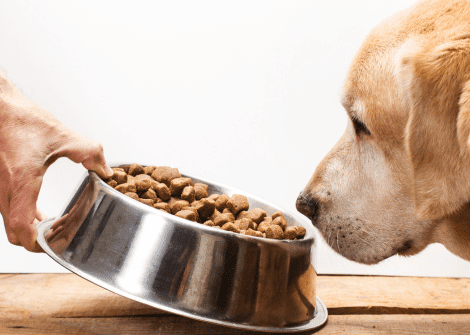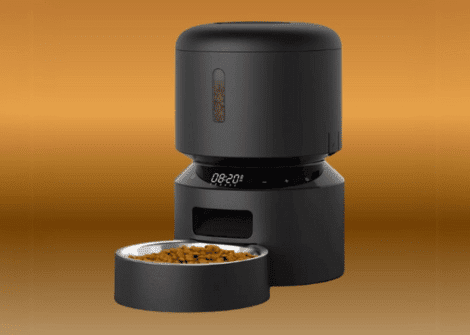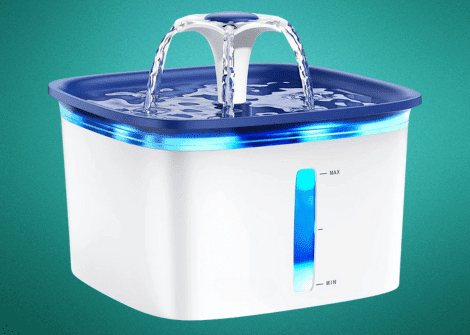How Much Should I Feed My Dog?
As a dog owner, you’re probably aware that a dog will eat whenever there’s any food in front of them. They’ll even wolf down food just minutes after you’ve given them a big bowl of their favorite meal! This is a natural instinct, as in the wild they are never sure when the next meal will be coming.
However, as a conscientious owner, you need to ensure that your dog receives the appropriate amount of food. Knowing how much to feed them and the correct portions is crucial for their health and well-being.
That’s because overfeeding can lead to obesity and related health issues, while underfeeding may result in slow malnutrition. In fact, dogs who are at their ideal weight live on average 2.5 years longer than overweight or underweight dogs.
This guide will help you determine the right feeding regimen for your canine companion, covering factors like age, size, activity level, and more.

Table Of Contents
Factors Influencing Your Dogs Dietary Needs
General Feeding Guidelines For Dogs
The Quality of Ingredients In Your Dog’s Food
How Much Dry Food Should I Feed My Dog?
How Much Wet Food Should I Feed My Dog?
How Much Should I Feed My Puppy?
How Much Food Should Active Dogs Eat?
How Much Food Does An Older Dog Need?
Factors Influencing Your Dog's Dietary Needs
From when they are a puppy through to their senior years, dogs need the right balance of nutrients, proteins, carbs and calories. Getting the right balance and correct quantity depends on several factors:
- Age: Puppies have different nutritional needs compared to adult or senior dogs.
- Size and Breed: Larger breeds may require more food than smaller ones.
- Activity Level: Active dogs burn more calories and may need more food.
- Health Status: Certain health conditions can affect appetite and metabolism.
Understanding these factors will help you tailor a feeding plan that meets your dog’s specific needs.
General Feeding Guidelines For Dogs
Feeding your dog the right amount of food is essential for their health, energy levels, and overall well-being. But with so many different dog food brands, it can be tricky to figure out exactly how much to feed your dog.
Most commercial dog food brands include feeding guidelines on the packaging. Be aware though that these charts are based on your dog’s weight, and don’t always account for other factors like activity level, age or size.
For example, a highly active Labrador Retriever will need more food than a lower-energy Bulldog of the same weight. Similarly, senior dogs require fewer calories than younger, more active pups.
Also, keep in mind these guidelines recommend a total daily portion – not a per meal portion!
A great way to fine-tune your dog’s portions is by monitoring their body condition. You should be able to feel (but not see) their ribs, and they should have a defined waistline when viewed from above. If they’re gaining or losing weight unexpectedly, it’s time to adjust their portions.
You do need a starting point, however – so here are some general guidelines on how much dry food and wet food to feed your dog:
The Quality Of Ingredients In Your Dog's Food
The quality of ingredients in your dog’s food plays a crucial role in their health, energy levels, and overall well-being. Not all dog foods are created equal, and understanding what goes into your pet’s diet can help you make better choices for their nutrition.
Remember: When you look at the ingredients on the packaging or can, the ingredients are listed in order from most to least. This means that the first few ingredients make up the majority of what’s in your dog’s food.
For example, if chicken is the first ingredient, that’s a great sign—it means there’s more chicken in the food than anything else. However, if the first ingredient is corn or wheat, that means the food contains more fillers than real protein.
By understanding how ingredients are listed, you can make sure your dog is getting nutritious, high-quality food instead of a meal filled with unnecessary fillers and additives!
Key Ingredients to Look For
- High-Quality Protein – The first ingredient should be a named protein source like chicken, beef, salmon, or lamb.
- Healthy Fats – Omega-3 and Omega-6 fatty acids from fish oil, flaxseed, or chicken fat support your dog’s skin, coat, and brain health.
- Wholesome Carbohydrates – Brown rice, sweet potatoes, and oatmeal provide sustained energy and are easier to digest than fillers like corn or wheat.
- Essential Vitamins and Minerals – Look for added calcium, phosphorus, and DHA, which are especially important for growing puppies and senior dogs.
- Named Meat by-products – As long as the by-products are named by source, then they are an acceptable ingredient – and one that dogs often love to eat. Therefore the ingredient should be listed as beef by-product, chicken by-product, turkey by-product, and so on.
Ingredients to Avoid
- Artificial Preservatives and Colors – Avoid BHA, BHT, and artificial dyes, which can be harmful.
- Excess Fillers – Corn, soy, and wheat offer little nutritional value and may cause allergies.
- Unnamed Meat by-products – If the ingredient says something like “meat meal”, “meat by-product” or “animal by-products”, these dog foods should be avoided. That’s because they are vague terms that may include low-quality protein sources, including road kill, dead zoo animals, and diseased livestock.
Final Thoughts
Choosing high-quality dog food with real, recognizable ingredients ensures your dog gets the nutrients they need to stay healthy and active – and live longer. So always check the ingredient list and opt for trusted brands that prioritize your dog’s nutrition and well-being.
How Much Dry Food Should I Feed My Dog?
Dry dog food, or kibble, is a popular choice due to its convenience and long shelf-life – and the fact it doesn’t require refrigeration. Take the recommended daily amount of kibble and divide by the number of meals you serve your dog each day to find the correct portion-size per meal – an ideal is to serve your dog two meals a day.
It’s important that you measure out the portion for each meal carefully, rather than just guessing, as too much or too little food can end up having health consequences for your dog.
| Dog’s Weight | Daily Amount |
|---|---|
| 3-12 lbs | ⅓ – 1 cup |
| 13-20 lbs | 1 – 1⅓ cups |
| 21-35 lbs | 1⅓ – 2 cups |
| 36-50 lbs | 2 – 2⅔ cups |
| 51-75 lbs | 2⅔ – 3⅓ cups |
| 76-100 lbs | 3⅓ – 4¼ cups |
| 101+ lbs | 4¼ cups + ¼ cup for each additional 10 lbs |
How Much Wet Food Should I Feed My Dog?
Many new dog owners think they should feed their dog one can of dog food per day. However, that’s definitely not the case!
As a rule of thumb, you need to feed your dog 1 can per 15 lbs of their body weight per day. You adjust to part-cans for dogs that weigh less than 15 lbs – and also adjust depending on their age, weight and activity levels.
Again, here’s a general guideline for total daily wet food portions. Remember it’s best to divide this amount into two meals spread across the day.
| Dog’s Weight | Daily Amount |
|---|---|
| 3-12 lbs | ½ – 1 can |
| 13-20 lbs | 1 – 1½ cans |
| 21-35 lbs | 1½ – 2 cans |
| 36-50 lbs | 2 – 2½ cans |
| 51-75 lbs | 2½ – 3½ cans |
| 76-100 lbs | 3½ – 4½ cans |
| 101+ lbs | 4½ cans + ½ can for each additional 10 lbs |
How Much Should I Feed My Puppy?
Puppies need more food per pound of body weight than adult dogs because they are growing rapidly and have higher energy needs.
If you decide to rear your puppy on dry food, then look for high-quality kibble made specifically for puppies, as it contains higher protein and fat levels to support their growing bodies.
Wet food, on the other hand, is softer and easier to chew, making it a great option for young puppies or small breeds. It also has a higher moisture content, which helps with hydration. However, it can be more expensive and may need to be combined with dry food for a balanced diet.
The amount puppies eat depends on their age, breed size, and activity level. Younger puppies require more frequent meals to support healthy development.
Below is a general guideline for how much dry and wet food to feed a puppy each day based on their age – and how many meals you should feed them each day.
Remember the table gives you the total amount you need to feed your puppy, which you then divide into the recommended number of meals per day.
| Age | Dry Food | Wet Food | |
|---|---|---|---|
| 6-12 Weeks | ½ – 1¼ cups | ½ – 1 can | |
| 3-4 Months | 1 – 2 cups | 1 – 1½ cans | |
| 5-6 Months | 1½ – 3 cups | 1½ – 2 cans | |
| 7-12 Months | 2 – 4 cups | 2 – 3 cans | |
| 12+ Months (Adult Transition) | Start your puppy on an adult diet based on their breed and weight | Start your puppy on an adult diet based on their breed and weight |
Puppies need nutrient-dense food to support their growth, bone development, and immune health. It’s important to adjust portion sizes as they grow and to transition them to adult food around 12 months (or a little later for large breeds).
How Much Food Should Active Dogs Eat?
Active dogs burn more calories than average pets, meaning they require larger portions to maintain their energy levels. As a general rule, an active dog needs 50% more food than less active dogs. Working dogs, sporting breeds, and highly active companions may need up to twice the amount of food. Their diet should be high in protein and healthy fats to support muscle recovery and sustained energy.
It’s also a good idea to feed active dogs 1/3 of their daily food in the morning at least 3 hours before any big activity like working or running. The remaining 2/3 should be given in the late afternoon or evening.
Below is a general guideline for feeding active dogs based on their weight, with recommended portions for both dry kibble and wet food.
| Dog’s Weight | Daily Dry Food Amount | Daily Wet Food Amount |
|---|---|---|
| 3-12 lbs | ½ – 1½ cups | ¾ – 1¾ can |
| 13-20 lbs | 1½ – 2⅔ cups | 1¾ – 3 cans |
| 21-35 lbs | 2⅔ – 4 cups | 3 – 4¼ cans |
| 36-50 lbs | 4 – 5¼ cups | 4¼ – 5½ cans |
| 51-75 lbs | 5¼ – 7 cups | 5½ – 7¼ cans |
| 76-100 lbs | 7 – 9 cups | 7¼ – 9½ cans |
| 101+ lbs | 9+ cups (add ½ cup per 10 lbs) | 9½+ cans (add ¾ can per 10 lbs) |
If your dog is highly active, adjusting their food intake is crucial to keep them healthy, strong, and full of energy. Always monitor their weight, muscle tone, and activity level, and adjust portions as needed. When in doubt, consult your veterinarian for a personalized feeding plan.
As dogs age, their metabolism slows, and they often become less active, meaning they require fewer calories than younger dogs. However, their diet should still be nutritionally balanced to support joint health, digestion, and muscle maintenance.
The exact amount of food a senior dog needs depends on their weight, activity level, and overall health. Below is a general guideline for how much dry and wet food to feed a senior dog daily based on their weight.
Keep in mind that as dogs age, they often develop dental problems, and so wet food is usually easier for them to eat.
| Dog’s Weight | Dry Food | Wet Food |
|---|---|---|
| 3-12 lbs | ¼ – ¾ cup | ⅓ – ¾ can |
| 13-20 lbs | ¾ – 1 cups | ¾ – 1⅓ cans |
| 21-35 lbs | 1 – 1¾ cups | 1⅓ – 1¾ cans |
| 36-50 lbs | 1¾ – 2⅓ cups | 1¾ – 2¼ cans |
| 51-75 lbs | 2⅓ – 3 cups | 2¼ – 3¼ cans |
| 76-100 lbs | 3 – 4 cups | 3¼ – 4¼ cans |
| 101+ lbs | 4 cups + ¼ cup per 10 lbs over 100 lbs | 4¼ cans + ¼ can per 10 lbs over 100 lbs |
These are general guidelines which should serve as a starting point. Be sure to monitor your dog’s weight and activity level and consult your veterinarian for personalized feeding recommendations.
Is Mixing Dry and Wet Dog Food Healthier for Your Dog?
Many dog owners wonder if combining dry and wet food is a healthier option for their pets. The good news is that mixing both can provide nutritional benefits while making mealtimes more enjoyable for your dog. Mixing dry and wet food also has these benefits:
✔ Better Hydration – Wet food has a high moisture content, helping dogs stay hydrated, especially those who don’t drink enough water.
✔ Improved Digestion – The softness of wet food can make it easier to digest, which is great for senior dogs or those with dental issues.
✔ Balanced Nutrition – Dry food is rich in fiber and crunchy texture, which helps support dental health, while wet food often contains higher-quality protein and fewer carbohydrates.
✔ More Palatable Meals – Picky eaters often find mixed food more appetizing than kibble alone.
Best Practices for Mixing Wet and Dry Food
It’s important when you mix dry and wet food together, you make sure the total caloric intake matches your dog’s daily requirements.
To make it easy, this rule of thumb will help: 1 cup of dry food = 1 can of dog food (13oz).
So if your dog needs 2 cups of kibble a day, then mixing 1 cup of kibble and 1 can of dog food will maintain their healthy diet.
It’s also a good idea to mix in the new type of food gradually, to help your dog adjust – and to prevent them from getting an upset stomach. Start by mixing in a spoonful or two of the new food and gradually increase the amount each day.
Monitoring Your Dog's Weight and Health
Regularly monitor your dog’s weight and body condition. Feel for their ribs; you should be able to easily feel them, but they shouldn’t be visible. Observe their waistline from above; there should be a noticeable curve inwards at the waistline. If your dog is gaining or losing weight unintentionally, adjust their food portions accordingly and consult your veterinarian.
Also, follow these tips:
- Consistent Feeding Schedule: Feed your dog at the same times each day to establish a routine.
- Measure Portions Accurately: Always use a measuring cup to ensure consistent portion sizes.
- Limit Treats: Treats should make up no more than 10% of your dog’s daily caloric intake.
- Provide Fresh Water: Always have clean, fresh water available for your dog. (You might want to check out our guide to Automatic Drinking Water Fountains For Your Dog.)
If you’re unsure about the appropriate amount to feed your dog or if your dog has specific health concerns, it’s always best to consult your veterinarian. They can provide personalized feeding recommendations based on your dog’s unique needs.
Final Thoughts
Determining the right amount to feed your dog involves considering various factors, including age, weight, activity level, and the type of food. Regular monitoring and consultation with your veterinarian will help ensure your dog maintains a healthy weight and enjoys a balanced diet.
Remember, these guidelines are starting points, and individual needs may vary. Always adjust portions based on your dog’s specific requirements and response to their diet.
Also, we all lead such busy lives these days, and spend a lot of time out of the house. If that is something your concerned about, you might want to consider using an Automatic Dog Feeder and a Smart Dog Water Fountain. This helps reduce the stress you’re under, and ensures your dog receives the right amount of food each day while also having access to fresh, running water.
More Reading
Your dog thrives when it has a routine, and automatic feeders ensure timely, portion-controlled meals. With WiFi connectivity, the best ones let you check in on your dog in real time as well.
Dogs love to drink running water, and a Smart drinking water fountain means that your dog always has a constant supply of fresh, clean water.
Smart dog doors are a great innovation in recent years. They use microchip recognition, collar tags, or app controls to let only your dog in and out, saving you time and giving your dog access to the outside when they need to go.



